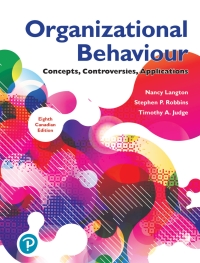Note : You are purchasing a standalone product; MyLab Management does not come packaged with this content. Students, if interested in purchasing this title with MyLab Management, ask your instructor for the correct package ISBN and Course ID. Instructors, contact your Pearson representative for more information. Organizational Behaviour, Eighth Canadian edition, is truly a Canadian product. While it draws upon the strongest aspects of its American cousin, it expresses its own vision and voice. It provides the context for understanding organizational behaviour (OB) in the Canadian workplace and highlights the many Canadian contributions to the field. Subject matter reflects the broad multicultural flavour of Canada and also highlights the roles of women and visible minorities in the workplace. Examples reflect the broad range of organizations in Canada: large, small, public and private sector, unionized and non-unionized. If you would like to purchase both the physical text and MyLab Management, search for: 0134860802 / 9780134860800 Organizational Behaviour: Concepts, Controversies, Applications, Eighth Canadian Edition Plus NEW MyManagementLab with Pearson eText -- Access Card Package, 8/e Package consists of: 0134645855 / 9780134645858 Organizational Behaviour: Concepts, Controversies, Applications, Eighth Canadian Edition, 8/e 0134882458 / 9780134882451 MyManagement with Pearson eText -- Standalone Access Card -- for Organizational Behaviour: Concepts, Controversies, Applications, Eighth Canadian Edition, 8/e
چکیده فارسی
توجه: شما در حال خرید یک محصول مستقل هستید. MyLab Management با این محتوا همراه نیست. دانشجویانی که علاقه مند به خرید این عنوان با MyLab Management هستند، از استاد خود ISBN و Course ID صحیح را بخواهند. مربیان، برای اطلاعات بیشتر با نماینده پیرسون خود تماس بگیرید. رفتار سازمانی، ویرایش هشتم کانادا، واقعاً یک محصول کانادایی است. در حالی که از قوی ترین جنبه های پسرعموی آمریکایی خود استفاده می کند، دیدگاه و صدای خود را بیان می کند. این زمینه را برای درک رفتار سازمانی (OB) در محل کار کانادا فراهم میکند و کمکهای کانادایی در این زمینه را برجسته میکند. موضوع منعکس کننده طعم گسترده چندفرهنگی کانادا است و همچنین نقش زنان و اقلیت های قابل مشاهده در محل کار را برجسته می کند. نمونهها طیف وسیعی از سازمانها را در کانادا منعکس میکنند: بزرگ، کوچک، بخش دولتی و خصوصی، اتحادیه و غیر اتحادیه. اگر میخواهید هم متن فیزیکی و هم مدیریت MyLab را بخرید، این موارد را جستجو کنید: 0134860802 / 9780134860800 رفتار سازمانی: مفاهیم، بحثها، برنامهها، نسخه هشتم کانادایی پلاس NEW MyManagementLab با پکیج Pearson eT. : 0134645855 / 9780134645858 رفتار سازمانی: مفاهیم، بحثها، برنامههای کاربردی، ویرایش هشتم کانادا، 8/e 0134882458 / 9780134882451، MyManagement eTexts، ETextro، Contraverses، Canadian، EText، برنامههای کاربردی، به همراه Peear. e
ادامه ...
بستن ...
Share this ebook on FacebookShare this ebook with email
Organizational Behaviour
Concepts, Controversies, Applications, Eighth Canadian Edition, (Subscription)
By: Nancy Langton; Stephen P. Robbins; Timothy A. Judge
- Publisher: Pearson Canada
-
Print ISBN: 9780134645858, 0134645855
Print ISBN: 9780134645858, 0134645855
-
eText ISBN: 9780134861166, 0134861167
eText ISBN: 9780134861166, 0134861167
- Edition: 8th
ادامه ...
بستن ...










